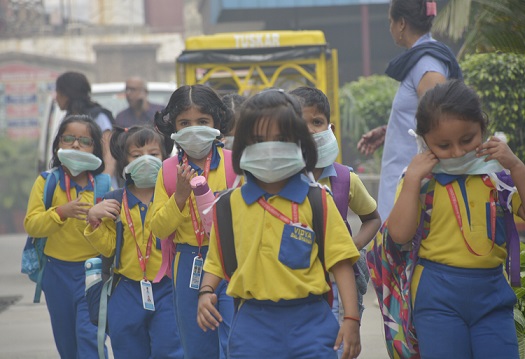India’s capital Delhi is gasping for breath and the fact that schools have been shut, flights diverted, construction work halted and public health emergency declared should tell a thing or two about the dire air-pollution blanketing world’s second most populous city of 30 million people.
Man and nature outdo each other every winter in producing a gas chamber which irreversibly damages the lungs of millions of children and makes air-pollution the fifth biggest killer of all–bigger than diabetes, smoking, high blood pressure and malnutrition.
The megalopolis lies lower than its surrounding areas which has dust blown in from the deserts (Rajasthan) and smoke from burning farms (Uttar Pradesh, Haryana and Punjab) that remains trapped due to stagnant air of cold winter. Tens of thousands of industries on its periphery, snarling trucks with construction materials which inject dust in air and at least 10 million vehicles on its artery of roads further choke the lungs of its residents.
The Air Quality Index (AQI) of Delhi registered a high of 484 this week which is in severe category, way above the 0-100 considered “good” and “satisfactory”. Half of this problem is due to stubble burning of crops in neighbouring states of Punjab and Haryana. Yet, twice as trickier is the solution than the problem would appear at first sight.
Every year, after the paddy harvest, farmers are left with stubble which has grown progressively stubborn over the years due to increased use of pesticides and fertilizers. It doesn’t interest cattle. It blunts the cutting instruments. Pulling it out is time and money-consuming. Transporting it further involves expense. With a fresh crop season beckoning, farmers opt for burning the stubble as an easy way out.
India is a federal nation and states and Centre often run at cross-purpose to each other. They haven’t found a way to incentivize the farmers to pull out the stubble and transport it, say to private power producers who in turn could be incentivized to use the stubble and its valuable biomass fuel into renewable electricity. Big players have already invested $42 billion in India’s renewable energy sector since 2014 and could lap up to this opportunity which would end the stubble menace. Thailand took a similar route to tackle rice husk issue and overcame it in five years.
One of the measures being tried by Delhi government presently is odd-even scheme for cars which is odd-numbered cars run on odd dates and even-numbered vehicles on even dates. However, since vehicles measure up to only 2% of the problem, this at best is a band-aid to what is a badly-infected body.
To be sure, Delhi isn’t the only Indian city grappling with clean air issue. Indeed, 22 of world’s 30 most polluted cities are in India. Population is one issue which makes India’s cities highly congested and reduce traffic to a crawl, filling the air with toxic smoke. Nearly 100 million Indians still use fuelwood and biomass cakes for cooking and general heating needs which World Health Organization (WHO) reckons leads to death of 400,000 people each year due to indoor carbon monoxide poisoning. India burns ten times more fuelwood every year than the United States. Most Indian cab drivers use adulterated fuel blends of gasoline and diesel to reduce their gas expenses but at a great cost to environment. India, lest we forget, is also the third largest emitter of carbon dioxide in the world, behind China and the United States.
India has woken up late to air-pollution but frankly so did the world–only around the turn of the 21st century. Humanity lived with bad air for centuries before realizing that air pollution is causing unimaginable health disasters. Today it accounts for one in nine deaths worldwide. It kills 7 million people a year, more than HIV, tuberculosis and malaria combined. Every single city in Middle East and Africa exceeds the WHO markers as does 99% of South Asian cities and 89% in East Asia. Even in Europe it accounts for 500,000 deaths per year.
In India, the air pollution act was passed in 1981. Since then India has formed its own National Air Quality Index. This year it has launched the National Clean Air Programme with 20-30 per cent pollution reduction target by 2024. This plan is specifically meant for 102 cities which are considered to have worse air quality than the national standards. After all, life can’t do without breathing.


